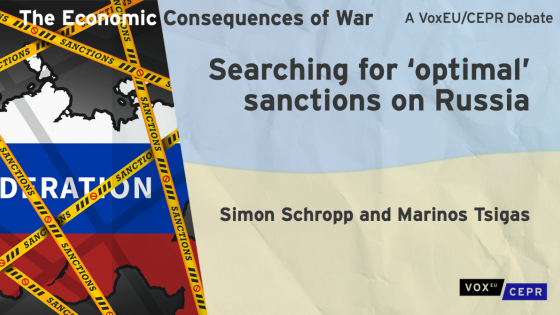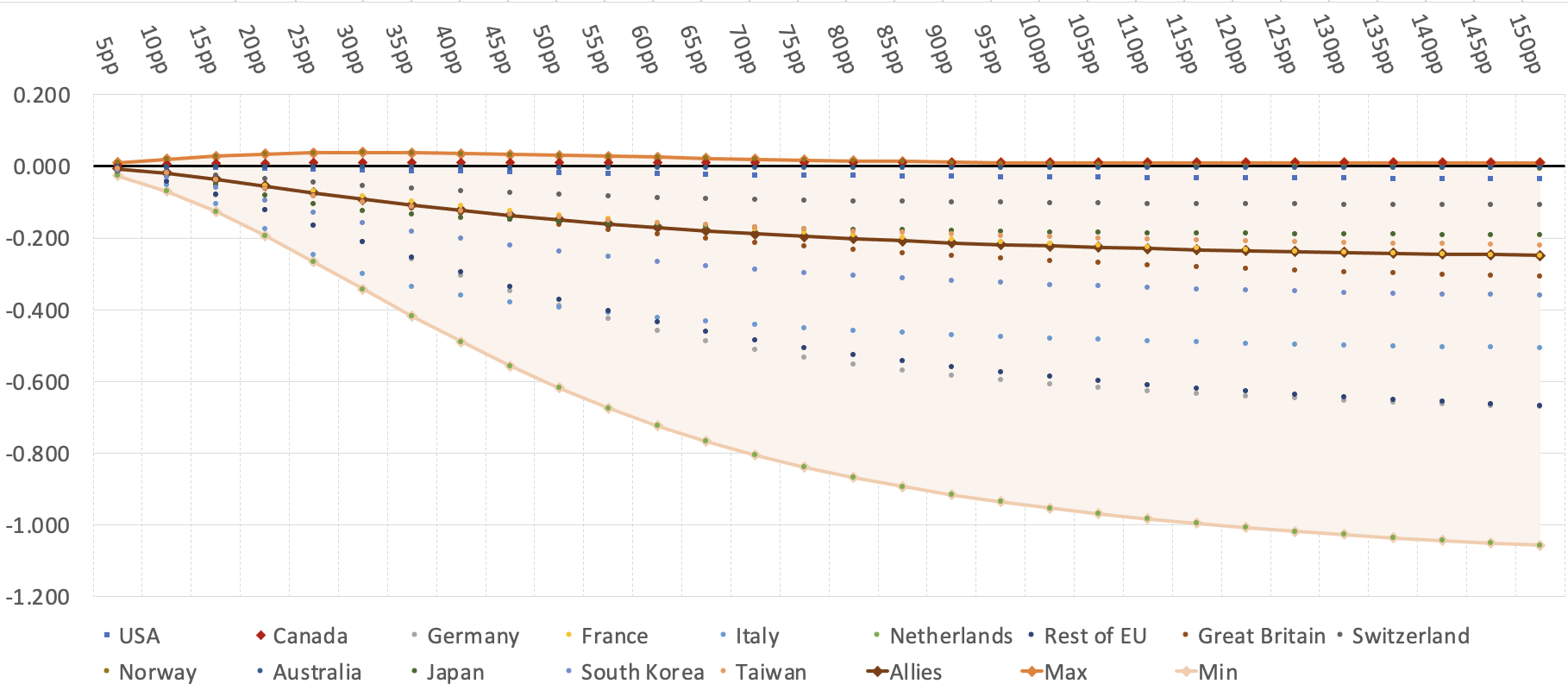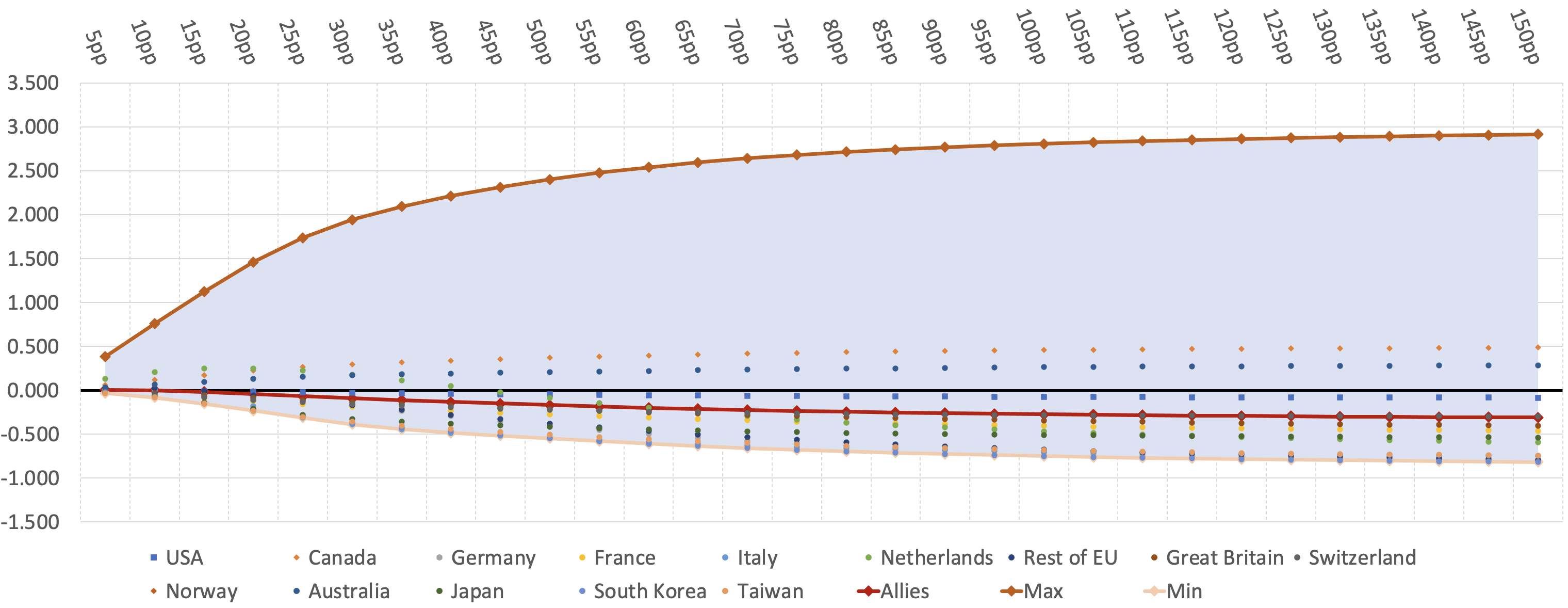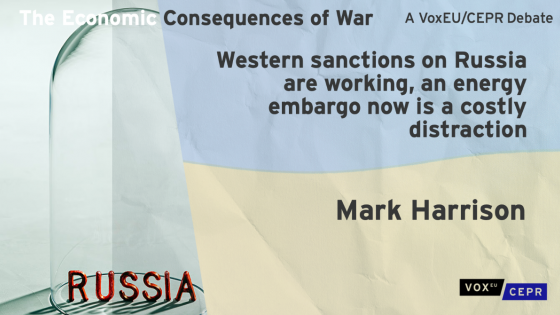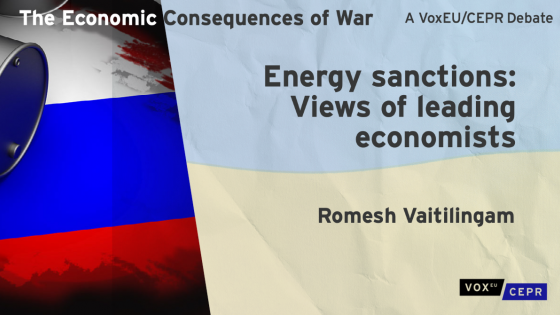Editors' note: This column is part of the Vox debate on the economic consequences of war.
In response to Russia’s war of aggression in Ukraine, an international coalition of at least 40 countries (the ‘Allies’) has formed to impose economic sanctions on Russia. Given the dependency of the Russian economy on exports, observers have suggested that increases of import tariffs on Russian exports are an important instrument available to the Allies (e.g. Hausman 2022, Chaney et al. 2022, Kennedy 2022). Compared to other types of sanctions, such as price caps or quotas, tariff increases have the benefit that they are relatively easy to administer and fast to implement. Non-prohibitive tariffs have the additional advantage that they generate extra tariff revenues for sanctioning countries.
A number of recent contributions apply computable general equilibrium (CGE) models to estimate the economic effects of Allied import measures on Russia (e.g. Chepeliev et al. 2022, Felbermayr et al. 2022, Evenett and Muendler 2022, Langot et al. 2022, Mahlstein et al. 2022, WTO 2022). These papers have either predicted complete import bans by the Allies, or simply assumed tariff increases of a certain magnitude. In addition, all these papers have exogenously imposed the set of Russian export sectors that would be targeted by the Allies.
In a recent paper (Schropp and Tsigas 2022), we endogenise, in the context of a CGE model, the scope of targeted sectors, the level of tariff increases, and the choice over how to disburse the additional tariff revenues generated by Allied sanctions. Using the well-known Global Trade Analysis Project (GTAP) framework, we answer three simple policy questions that may help the Allies design an efficient sanction strategy on Russia:
1. Should the Allies target all imports from Russia or only a subset of sectors?
2. By how much should the Allies increase tariffs on Russian imports?
3. Is it economically advantageous to enact burden-sharing arrangements in which the Allies support the countries most affected by Allied sanctions?
Our analysis is guided by the assumption that the Allies act in a coordinated fashion and pursue three objectives: (i) maximise Russia’s economic pain, while at the same time (ii) minimising that of the Allies and (iii) keeping the distribution of economic gains and losses among Allies as narrow as possible.1
Which Russian export sectors should Allies target?
To address research question (1) on sanction scope we simulate effects of various levels of Allied import tariff increases on Russian exports in terms of real GDP and real income – for Russia (Figure 1) and for the weighted average across Allies (Figure 2).2 Each panel compares two interventions: Allied import tariff hikes on all Russian exports (dashed lines) and on the eight sectors in which the majority of Allied imports occur (solid lines).3
Panel a) of Figure 1 shows that Russia’s real-GDP losses are higher when Allies limit themselves to targeting a subset of sectors only. This is true irrespective of the level of import tariff hikes, i.e. along the entire x-axes.4 Looking at real-income changes in panel b), Russian losses from Allied sanctions on all sectors are consistently, albeit only minimally, larger than those on the eight sectors.
Figure 1 Percent change in Russian real GDP and real income (all versus limited set of sectors)
Source: Schropp and Tsigas (2022).
For the Allies, Figure 2 reveals that real-GDP losses, shown in panel a), resulting from the two interventions are practically identical for tariff increases under 30 percentage points, from which point onwards Allied losses are smaller for the limited set of target sectors.5 Looking at the real income effects of import sanctions on the Allies, in panel b), the Allied loss curve for targeting all sectors is marginally above that for the eight products for tariff increases under 80 percentage points, at which point the curves cross and a focus on eight sectors becomes slightly more advantageous for the Allies.
Figure 2 Percent change in Allied real GDP and real income (GDP-weighted; all versus limited set of sectors)
Source: Schropp and Tsigas (2022).
The analysis summarised in Figures 1 and 2 suggests that the superior scope of target sectors by the Allies may not be an across-the-board import tariff. Rather, it may be favourable for the Allies to consider selective import tariff increases on particular target sectors. Doing so may result in higher economic losses to Russia, potentially coupled with higher gains or smaller losses to the Allies themselves. In that sense, focusing Allied import sanctions on the eight most-imported sectors may be a step towards the Allies’ optimal sanction strategy.6
By how much should the Allies raise import tariffs on Russian products?
Moving on to the optimal sanction level (research question (2)), consider again Figures 1 and 2, which depict the economic effects of tariff increases of different magnitude.
For Russia, the solid line in panel a) of Figure 1 shows that the Russian real-GDP losses hit a maximum at the 25 percentage point mark for the eight selected sectors. For higher tariff hikes, Russia’s losses diminish again, and asymptotically approach the terminal loss suffered from a complete import ban (approximated by the 150 percentage point mark).7 Looking at real income effects, Russia’s loss curve no longer exhibits a kink. Rather, Russia’s real income loss curve declines at a slowing rate.8
The allies must trade off import sanctions with real-GDP losses throughout (Figure 2, panel a)). Losses are small for moderate tariff hikes and then increase, albeit at a declining rate. When it comes to real income, panel b) of Figure 2 reports that the Allies experience small gains at small levels of tariff increase below 15 percentage points.9 However, already at moderately higher tariff levels, real income gains turn into losses that deteriorate at a declining rate as tariff hikes get larger.
To visualise the disparities of real GDP losses between the Allies in the coalition, Figure 3 (for real GDP) and Figure 4 (for real income) plot country-specific results around the Allied loss curves. The tighter the dispersion (vertical distance) for any tariff level, the more equitable the results are from the perspective of Allied policymakers. The dispersion around the Allied loss curves is smallest for small tariff increases, and then expands considerably as tariff hikes get bigger, which suggests fairly inequitable distribution of gains and losses among the Allies for higher sanction levels.
Figure 3 Dispersion of real-GDP effects across Allies, eight selected sectors (%)
Source: Schropp and Tsigas (2022).
Figure 4 Dispersion of real income effects across Allies, eight selected sectors (%)
Source: Schropp and Tsigas (2022).
What can we learn from these findings about sanction design and an optimal Allied sanctions strategy? To capture the maxim that the aim of sanctions is to cause harm to the sanctions target, Russia’s economic welfare must enter negatively in the Allies’ utility function.10 While it is evidently up to Allied policymakers to determine how exactly to strike the balance between inflicting harm to Russia and sustaining self-harm across Allied economies, Figure 1 through Figure 4 do suggest a focal point. Regardless of whether the Allies’ main intent is to harm Russia to the fullest extent, or whether the degree of self-harm and fair distribution of gains and losses enter into the Allies’ utility functions more prominently, an import tariff increase of 25 percentage points appears to be the optimal sanction level.
- At the 25 percentage point tariff-increase level, the Russian real GDP loss curve shows a local minimum, which implies a maximum loss to Russia.11 Looking at real income effects, panel b) of Figure 1 suggested that to the right of the 25 percentage point mark, the steepness of the Russian loss curve starts petering out. This implies less ‘bang for the buck’ for the Allies beyond the 25 percentage point mark, i.e. smaller marginal effects for each additional percentage point tariff increase.
- As for self-harm that the Allies inflict upon themselves by imposing sanctions on Russia, economic losses at the 25 percentage point mark are moderate (under 0.1%, see Figure 2). Moreover, around the 25 percentage point mark, the Allied loss curves begin flattening out, meaning that additional tariff increases cause less and less incremental self-harm, which also is in the Allies’ interest.
- As for the divergence of gains and losses between Allies, Figure 3 and Figure 4 suggest that economic harm at or around the 25 percentage point mark is still relatively equitable (particularly if one disregards outliers Netherlands and Norway).
The above suggests that the optimal sanction level by the Allies is not a full-on embargo. Rather, a concerted tariff increase of at or around 25 percentage point appears preferable. At that sanction level, the willingness of the Allies to trade off harm to Russia on the one hand, and self-harm to Allies and equitable dispersion of the sanction burden on the other hand, are optimally balanced.
Are burden-sharing programmes effective?
Allied sanctions in the form of tariff hikes on Russian imports generate rents that the Allies would not have otherwise reaped (referred to as ‘additional tariff rents’). While trade models conventionally assume that tariff rents are ‘thrown back into the water’ – that is, treated as windfall spending for the importing government and dispersed among domestic sectors – this need not be the case. Observing the unequal distribution of economic pains and gains that result from an import sanction regime (Figure 3 and Figure 4), the Allies may decide to use additional tariff rents collected from Russia to strengthen cohesion, resilience, and longevity of the Alliance, and to prevent countries from abandoning the group of Allies.
We model an Allied adjustment-assistance program, in which coalition members voluntarily provide cash transfers to hardest-hit coalition members with the aim of equalising the economic burden across the Allies.12 Figure 5 compares real-income effects for the Allies and Russia in two scenarios: the base case without burden-sharing arrangement (see previous section), and the alternative case with burden-sharing in place.
Panel a) of Figure 5 captures two important implications related to Allied burden sharing: first, any dispersion around the Allied loss curve vanishes with the introduction of burden sharing.13 This yields a perfectly equitable distribution of real-income gains and losses across all Allies. Second, average Allied real-income losses with and without burden sharing are practically identical (comparing the solid orange with the dotted blue line); the two loss curves in each panel are nearly superposed.
As for the effects of burden-sharing on Russia, panel b) shows that the two real-income loss curves are quite similar. Yet, Russian real-income losses with burden sharing in place are marginally larger than those without, irrespective of the tariff sanction chosen. Burden-sharing scheme among Allies thus causes marginally more harm to Russia than no burden sharing – which should be in Allies’ interest.
Figure 5 Percent change in real income with and without a burden-sharing arrangement, eight selected sectors
Source: Schropp and Tsigas (2022).
Conclusion
We outline design choices towards an ‘optimal sanction’ strategy in the context of the GTAP framework, endogenising the choices of (i) target-sector scope, (ii) level of tariff increases, and (iii) redistribution of additional tariff revenues generated by the tariffs sanctions. Our main findings are:
- An optimal sanction strategy may not involve across-the-board import measures on Russia. Rather, the Allies may find it in their interest to limit the scope of sanction targets to a small number of Russian export sectors only. Specifically, we have shown that – compared to an across-the-board tariff increase – targeted sanctions on eight Russian sectors whose products are most imported by the Allies can result in higher economic losses to Russia and lower levels of self-harm to the Allies themselves.
- The optimal sanction level by the Allies is likely not a full-on embargo on target sectors, but rather concerted tariff increases of a magnitude of 25 percentage points.
- Burden-sharing arrangements that involve redistribution of tariff revenue and supplementary cash transfers between Allies can eradicate controversial disparities in economic gains and losses within the Allied coalition, thus achieving equitability of the sanction burden. This not only strengthens the cohesion, resilience, and longevity of the Allied coalition; it may also increase economic harm for Russia, and does so at little to no ‘cost’ (in terms of extra losses) to the Allies. This suggests that burden-sharing arrangements should be considered in the design of any optimal sanction strategy.
References
Chaney, E, C Gollier, T Philippon and R Portes (2022), “Economics and politics of measures to stop financing Russian aggression against Ukraine”, VoxEU.org, 22 March.
Chepeliev, M, T Hertel and D van der Mensbrugghe (2022), “Cutting Russia’s fossil fuel exports: Short-term pain for long-term gain”, VoxEU.org, 9 March.
Evenett, S and M-A Muendler (2022), “Making Moscow Pay - How Much Extra Bite Will G7 & EU Trade Sanctions have?”, UC San Diego.
Felbermayr, G, H Mahlkow and A Sandkamp (2022), “Cutting through the Value Chain: The Long-Run Effects of Decoupling the East from the West”, Kiel Institute for the World Economy Working Paper.
Gros, D (2022), “Optimal tariff versus optimal sanction : the case of European gas imports from Russia”, EUI Policy Brief.
Johnson, H (1951), “Optimum welfare and maximum revenue tariffs”, The Review of Economic Studies 19(1): 28-35.
Kennedy, C (2022), “Russian Oil’s Achilles Heel: How to Enhance the Impact of Oil Sanctions”, Substack.
Langot, F, F Malherbet, R Norbiato and F Tripier (2022), “Strength in unity: The economic cost of trade restrictions on Russia”, VoxEU.org, 22 April.
Mahlstein, K, C McDaniel, S Schropp and M Tsigas (2022), “Estimating the Economic Effects of Sanctions on Russia: an Allied Trade Embargo”, EUI Robert Schuman Centre Working Paper.
Schropp, S and M Tsigas (2022), “Designing ‘optimal’ sanctions on Russian imports”, EUI Robert Schuman Centre Working Paper.
Sturm, J (2022), “A Note on Designing Economic Sanctions”, Working Paper.
Sturm, J and K Menzel (2022), “The Simple Economics of Optimal Sanctions: The Case of EU-Russia Oil and Gas Trade”, Working Paper.
World Trade Organization (2022), “The Crisis in Ukraine Implications of the war for global trade and development”, Secretariat Note.
Endnotes
1 We include objective (iii) because we acknowledge concerns of fairness and equitability across countries: policymakers in any Allied country that suffers excessive economic losses relative to the other Allies may feel that their country is “bearing the brunt” of the sanctions efforts. As for Allies that experience outsized economic gains from the imposition of sanctions, such countries may be seen as “profiteers”, making hay of an otherwise dire situation, and on the back of other, less fortunate, Allies. In that sense, as far as economic effects on Allies go, outliers in any direction may threaten the cohesiveness and longevity of the Allied coalition. Thus, an equitable dispersion of the sanction burden appears to be a worthwhile, albeit probably not the most important, objective from the perspective of the Allies.
2 We measure tariff hikes in terms of percentage point increases and assume that Allies agree to coordinate their actions so as to increase import tariffs by the same magnitude.
3 The eight Russian sectors that are most imported by the Allies include oil, gas, coal, petro and coal products, various non-precious metals, chemical products, and gas distribution. These sectors together account for over 80% of all Allied imports from Russia.
4 The reason for higher Russian losses in the context of a more limited scope of target sectors is as follows: the imposition of import tariffs on a crucial subset of the Russian economy forces the country to engage in inefficient reallocation of resources – away from the comparatively efficient export sectors, and towards (non-sanctioned) sectors in which Russia’s comparative advantage is smaller. The need for reshuffling of resources is less pronounced if all Russian sectors are equally affected by Allied across-the-board import measures.
5 The reason behind lower Allied losses for higher sanctions is straightforward: when limited to eight sectors, Allies can continue to import non-sanctioned Russian products, thus avoiding potential self-harm resulting from sanctions. Lower levels of self-harm from a limited target scope are particularly pertinent at higher tariff increases.
6 From here on, we thus focus our analysis on a limited target scope of the eight sectors. Note that we have run the results presented below for the alternative intervention, in which all Russian export sectors are targeted. These results are available upon request.
7 The dynamics behind the kink in Russia’s real-GDP loss curve can be explained by the existence of high export taxes imposed by Russia on oil, gas, and petroleum and coal products, and on the interaction of these export taxes with Allied import tariffs. At lower levels, Allied import tariffs amplify the harmful effect of Russian export taxes – import tariffs and export taxes together stymy Russian exports of oil and gas. This results in inefficient reallocation of Russian resources, thus weakening Russia’s economy. Yet, as Allied import tariffs increase and Russia’s export volumes decrease, the marginal effect of Russian export taxes diminishes at an increasing rate.
8 The reason for higher Russian real-income losses (compared to real-GDP losses) is a significant terms-of-trade deterioration resulting from Allied sanctions. Since the price effect dominates the real effects, the kink observed in panel a) of Figure 1 evens out due to steady terms-of-trade losses that result from increasing tariff levels.
9 This is an illustration of the optimal-tariff theory dating back to Johnson (1951).
10 See Gros (2022), Sturm (2022), Sturm and Menzel (2022) for a formalisation of this in the context of partial-equilibrium models.
11 After the 25 percentage point mark, the slope of Russia’s loss curve turns positive, which implies that additional tariff increases lead to smallerlosses, which is not in the Allies’ interest. Hence, further tariff increases would only be acceptable if Allies’ own losses were to decline at tariff increase levels above the 25 percentage point mark, which is not the case, as Figure 2 confirms.
12 Additional tariff rents collected by individual Allied countries from continued importation of Russian products are first pooled and then distributed among Allies. If additional tariff revenues are insufficient to equalise economic gains and losses across Allies, we assume further cash transfers between Allies. Allies receiving transfers will reinvest these funds into their own economies. The result is equal losses and gains (in %) across all Allies. We structure the transfer scheme such that real-income gains/losses across Allies are equalised. Similar results ensue if we were to equalise real-GDP losses.
13 Note that the dispersion around the Allied loss curve with burden-sharing (blue dotted line) is zero by definition, because, as explained, our model is calibrated such that Allied cash transfers equalise real-income gains or losses among Allies.
